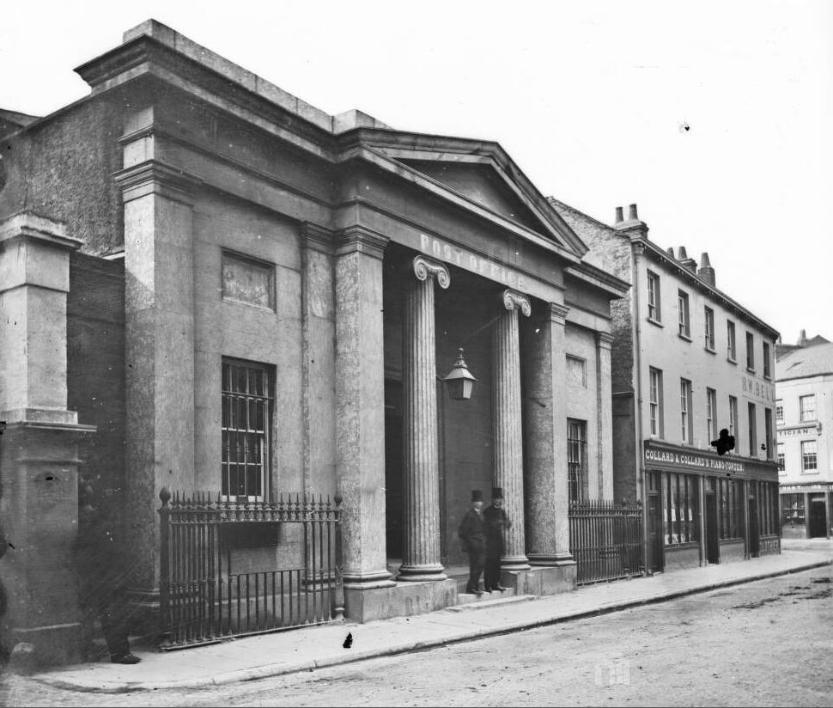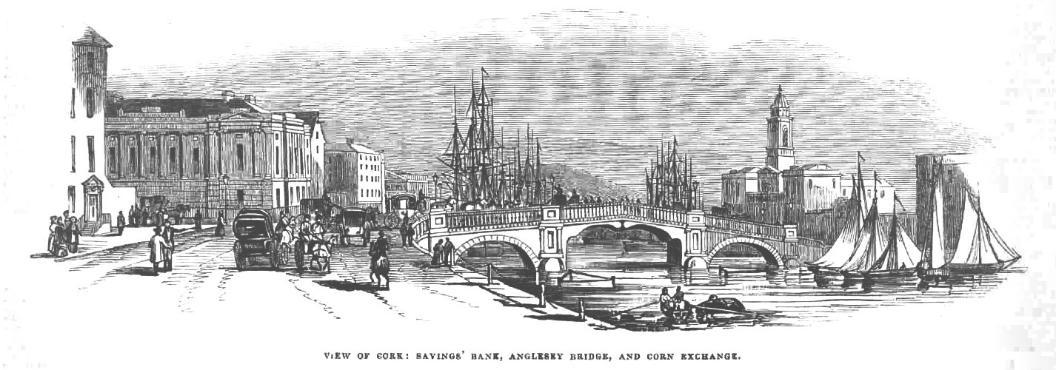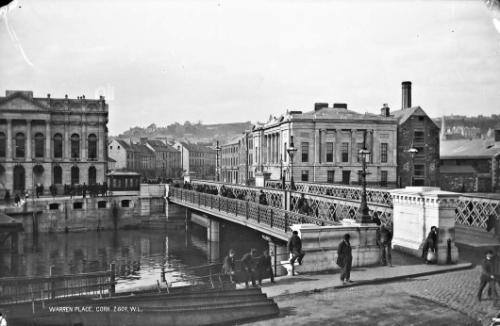Lapps Quay

This landmark building in the heart of Cork city houses Cork University Business School and Irish Management Institute programmes, bringing together the largest business school in Ireland with the leading, internationally ranked leadership and executive education institute in the country. The opening of the UCC Centre for Executive Education is the latest University building to open in a city centre location.
An Tánaiste and Minister for Foreign Affairs, Simon Coveney TD, officially opened the University College Cork Centre for Executive Education at 1 Lapps Quay in Cork on 26 November 2018. Speaking at the opening of the UCC Centre for Executive Education, An Tánaiste Simon Coveney said, “Located in the heart of Cork city, this building represents the ambition and commitment of University College Cork in leading Ireland’s future business and executive education. In bringing together Cork University Business School and IMI, professionals across a wide range of sectors will benefit enormously from the synergies and vision represented by this magnificent building which has had a long history of banking, and will now continue to enrich people’s lives and our business environment.”
The building at 1 Lapp’s Quay is a listed property, built in the early 1840s as the home of the Cork Savings Bank. The building fronts on to Lapp’s Quay, facing the River Lee and the side is on Parnell Place. No 16 Parnell Place is the former secretary's house.
The significance of the former Savings Bank is acknowledged in its inclusion on the City Development Plan 2015-2021, Volume 3 Specific Built Heritage Objectives (Cork City Record of Protected Structures number PS157). Both the Savings Bank and the secretary’s house at 16 Parnell Place are included on the National Inventory of Architectural Heritage’s survey of Cork City (registration numbers 20512967 (16 Parnell Place) and 20512968 (1 Lapp’s Quay)). Both are awarded architectural categories of special interest and the former bank building is awarded social and artistic categories in addition.
The bank building stayed in continuous banking use from its construction until late 2012 and has retained the majority of its original architectural features and fittings including external stonework, floorplan, roof structure, joinery, plasterwork, woodwork and fireplaces.
The Cork Savings Bank
 The Cork Savings Bank (CSB) opened on 20 December 1817. Its first premises were in a room of the Royal Cork Institution, Emmet Place. Then in 1824 its first building, designed by local young architect, Thomas Deane, was erected on Pembroke Street.[1] This building later became the General Post Office (see photo) and was on the site of the present GPO. The Cork Savings Bank moved to its new building on Lapp’s Quay on Saturday, 20 August 1842: the Trustees had breakfast in the Boardroom.
The Cork Savings Bank (CSB) opened on 20 December 1817. Its first premises were in a room of the Royal Cork Institution, Emmet Place. Then in 1824 its first building, designed by local young architect, Thomas Deane, was erected on Pembroke Street.[1] This building later became the General Post Office (see photo) and was on the site of the present GPO. The Cork Savings Bank moved to its new building on Lapp’s Quay on Saturday, 20 August 1842: the Trustees had breakfast in the Boardroom.
The CSB was independent from 1817 until 1986 when it merged with the Limerick Savings Bank forming the Cork and Limerick Savings Bank. In 1992 TSB Dublin merged with the C&L Savings Bank to form the Trustee Savings Bank (TSB). In 2001 TSB Bank joined the Irish Life & Permanent Group and the name changed to Permanent TSB. This branch of Permanent TSB closed in 2012. For more about the history of the PTSB, visit the PTSB Heritage website.
1 Lapp’s Quay
The Trustees of the Bank advertised in February 1839 seeking a plot of ground on which they proposed to build a new bank. It was stipulated that the site had to be 'not less than 60 feet in front, by 100 to 120 feet in depth'.[2] On 3 December 1839 the Trustees met to consider tenders from builders for the construction of a new bank building.[3] Drawings including elevations, sections and plans indicate that Henry Hill, a Cork architect, may have competed for the project.[4] In the event it was Thomas Deane and his brother Kearns Deane who designed the new building, with the brothers superintending the construction of the new bank on the corner of Lapp’s Quay and Parnell Place.[5] The contractor was Mr T. Fitzgerald. A plaque commemorating the architects and builder was erected inside the building and remains there today.

The constructed building is 32.9m on Parnell Place and 18.8m on Lapp’s Quay. This purpose-built bank is a corner-sited five-bay two-storey neo-Classical style building of limestone from the quarries at nearby Ballinlough, with the ground floor walls faced with ashlar. The slate roof is hipped and pitched with an ashlar limestone stepped parapet. The original timber panelled door has been retained. The original ground floor contained the Banking Hall and a manager’s office. The Banking Hall (or 'Cash Office') measures 15.8m × 11.8m and is 12m in height, originally with fittings of Spanish mahogany. Upstairs on the first floor there is a grand boardroom with views over the River Lee. In 1841 tenders were sought for the high detailed iron railing that still surrounds the building today.[6] At the end of that year, the fit out of the building began, with a call for estimates for 'Erecting the Counter and other Fittings of the New Savings Bank'.[7] The total cost of the building was £11,000. Sir Thomas was, with his business partner Benjamin Woodward, one of the architects of Queen’s College Cork (now UCC) in the late 1840s.
The work continued until August 1842 when the public were informed that the 'New Bank, Warren's Place', would open on the 20 August 1842. At a meeting of the Trustees and Managers of the Cork Savings’ Bank, a vote of thanks was made to the architects, Sir Thomas Deane and Kearns Deane, Esquire, 'for the very able and zealous manner in which they have executed their Plans, whereby an Edifice has been raised in our City, at once convenient in arrangement, appropriate in Design, and beautiful in Structure.'[8] The photo below, from the Lawrence Collection at the National Library of Ireland, shows the Bank in about 1900.
A few months later, in October 1842, the Committee of the bank advertised for tenders for building 'a porch in the Hall of the Bank'.[9] When a larger than life-size statue of William Crawford, senior, was sculpted by the Irishman John Hogan, it was too large for any other space in the city and was installed by Hogan himself in 1846: 'Hogan, the sculptor, has arrived in Cork, and remains for a month to superintend the erection of his statue of the late W. Crawford, Esq., in the Savings’ Bank'.[10] For many years the statue was in the Banking Hall until it was moved to the Crawford Art Gallery in 1957.[11] Also in the Banking Hall is a large portrait of James Craig, long-time Treasurer of the Cork Savings' Bank, now in the UCC Curatorial Collections. In 1873 improvements that included 'Cementing and other Repairs' were carried out to 1 Lapp’s Quay under instruction from Cork architects Henry and Arthur Hill.[12] In the same year, the Hills also took charge of improvements to the bank and the secretary’s residence, including a new front to that building: 'The same architects and builder [i.e., Messrs Henry and Arthur Hill, architects; Mr Samuel Thomas, of Cork, contractor] are now engaged in carrying out the works of improvement to the Cork Savings Bank buildings, and secretary’s residence in connection therewith, embracing a new front to the latter, facing Warren’s-place'.[13] Further renovations were carried out in 1950 under the instruction of Henry Houghton Hill,[14] and in 1954 Chillingworth & Levie who were responsible for additional toilet accommodation to the building.[15] These extensions housing toilets and an additional staircase were located to the eastern side of the building in the yard.
In 1843 the annual meeting of the British Association for the Advancement of Science (BAAS) was held in Cork, which was marked by a few pages in the Illustrated London News, including an engraving showing the Savings Bank.

In 1863, the CSB advertised for a porter and a female attendant or servant (who would be a female relative of the porter).[16] The wages were 12 shillings a week for the porter and 5 shillings for the female employee. In addition, accommodation 'in the bank' and fuel would be provided as well as livery for the porter. This accommodation was possibly in the attic of the bank.
No 16 Parnell Place
 No 16 Parnell Place, adjacent to the former bank building, is a terraced three-bay three-storey former house, built in about 1846. The Building Committee advertised in February 1846 seeking proposals for the erection of 'a dwelling house' adjoining the Bank at Warren’s (Parnell) Place.[17] The architect was Kearns Deane, Deane Street, Lapp’s Island. An internal door in the north-west corner of the Banking Hall connected with this house. (The matching door on the north-east of the Banking Hall led to the safe.) In 1873 this building was refaced by the architects Henry and Arthur Hill (as mentioned above).
No 16 Parnell Place, adjacent to the former bank building, is a terraced three-bay three-storey former house, built in about 1846. The Building Committee advertised in February 1846 seeking proposals for the erection of 'a dwelling house' adjoining the Bank at Warren’s (Parnell) Place.[17] The architect was Kearns Deane, Deane Street, Lapp’s Island. An internal door in the north-west corner of the Banking Hall connected with this house. (The matching door on the north-east of the Banking Hall led to the safe.) In 1873 this building was refaced by the architects Henry and Arthur Hill (as mentioned above).
This was the residence of the secretary of the Cork Savings Bank. The secretary, who reported to the Trustees, received a salary (£200 in 1873, rising to £250 in 1886) and accommodation.
From 1829 onward, the secretaries included: John Besnard, until 1862; then, John F. Harvey and his son John H. Harvey, appointed 1870; Charles Ross Munro, appointed in 1873; succeeded by Henry Carr Cave, who was appointed in 1886 and can be seen as still living in the house with his family and domestic servants in the 1901 and 1911 Census. By 1911, Cave's son William is a bank officer. According to the death certificate, Cave died at ‘Savings Bank House’, aged 81, in 1929. It will be interesting to see whether Cave was still the bank's secretary in 1926 when that census is released in 2026.
Acquisition by UCC
The buildings were purchased by UCC in 2016 from Cork City Council. To facilitate the refurbishment and reuse of the original bank building, a new extension was constructed within the enclosed yard to the east. This enables circulation across the upper floors of 16 Parnell Place to the upstairs rooms of 1 Lapp's Quay thus avoiding the necessity to go through the former Banking Hall. The Banking Hall and lecture rooms are available for large groups at lectures or events. Support functions and required services have also been efficiently catered for in this new construction, and enable the maintenance of the large historic rooms in their original form. Using the narrow space in the yard means that the new accommodation is hidden from exterior view thus preserving the historic streetscape. The buildings now house the UCC Centre for Executive Education in the College of Business and Law.
This project was delivered by the Capital Projects team, Buildings & Estates, UCC. The design team comprised: JCA Architects, civil and structural engineers Horgan Lynch, mechanical and electrical engineering by RPS Group, and quantity surveyors Michael Barrett Partnership. The contractor was Summerhill Construction.
References
[1] John Windele, Historical and descriptive notices of the city of Cork (Cork: Luke H. Bolster, 1839), 108-109.
[2] Advertisement, ‘Building ground’, Southern Reporter, 7 February 1839, 3.
[3] Advertisement, ‘Savings’ Bank, Cork. To Builders, &c.’, Southern Reporter, 26 November 1839, 1.
[4] Dictionary of Irish Architects: ‘CO. CORK, CORK, LAPP'S QUAY (& PARNELL PLACE), CORK SAVINGS BANK’, circa 1835.
[5] Cork Standard, 25 October 1839; John Windele, Historical and descriptive notices of the city of Cork (Cork: Bradford & Co., 1849), 120-121; 'Cork Savings Bank, 1817-1917', Journal of the Cork Historical and Archaeological Society, Vol. 23, No. 116 (1917) pp 177-185 (181); T. F. McNamara, Portrait of Cork (Cork: Watermans, 1981), 112; Frederick O’Dwyer, The Architecture of Deane and Woodward (Cork: Cork University Press, 1997), 23, 25 (illus.), 26, 553n.
[6] Advertisement, ‘Cork Savings’ Bank. Iron railing’, Southern Reporter, 15 June 1841, 2.
[7] Advertisement, ‘To Cabinet Makers and Others. Cork Savings’ Bank’, Cork Examiner, 31 December 1841, 1.
[8] Advertisement, ‘Cork Savings’ Bank’, Southern Reporter, 16 August 1842, 2.
[9] Advertisement, ‘Saving Bank.—To Builders’, Southern Reporter, 25 October 1842, 2.
[10] ‘News of the Week: Domestic’, The Nation, 25 July 1846, 644.
[11] John Turpin, John Hogan: Irish neoclassical sculptor in Rome (Blackrock, Co. Dublin: Irish Academic Press, 1982), 71 (illus.), 142-143; Crawford Art Gallery CAG.658.
[12] Advertisement, ‘Cork Savings’ Bank’, Cork Examiner, 3 May 1873, 4.
[13] ‘Notes from the South’, Irish Builder 15 (15 May 1873), 140.
[14] Irish Builder 92 (11 November 1950), 1216.
[15] Irish Builder 96 (24 April 1954), 417. The Chillingworth & Levie archive is located in the Cork City and County Archives.
[16] Advertisement, ‘Wanted’, Cork Examiner, 17 November 1863, 2.
[17] Advertisement, ‘To Builders’, Cork Examiner, 6 February 1846, 3.
Geographical information
No 1 Lapp’s Quay
Irish grid coordinates: Easting 167922, Northing 71815.
Latitude: 51° 53' 53.242049” N
Longitude: -8° 8' 0.218731” E
No 16 Parnell Place
Irish grid coordinates: Easting 167915, Northing 71835
Latitude: 51° 53' 53.887653
Longitude: -8° 28' 0.59151
Sources
Census of Ireland, 1901 and 1911: Cork No. 6 Urban, National Archives of Ireland
'Cork Savings Bank, 1817-1917', Journal of the Cork Historical and Archaeological Society, Vol. 23, No. 116 (1917), 177-185
Dictionary of Irish Architects: Works at Lapp’s Quay
Dictionary of Irish Architects: Chillingworth & Levie
Dictionary of Irish Architects: Henry Hill
Dictionary of Irish Architects: Henry Houghton Hill
National Library of Ireland, Lawrence Collection: STP_0575 Pembroke Street, Post Office, etc.
National Library of Ireland, Lawrence Collection: L_CAB_02809 Warren Place, Cork City
No 16 Parnell Place: NIAH Reg No 20512967
No 1 Lapp’s Quay: NIAH Reg No 20512968
Ordnance Survey, City of Cork: sheet LXXIV.56 (1869)
Ordnance Survey, City of Cork: sheet LXXIV.56 (1893)
Permanent TSB Heritage (accessed 12/10/2021)
'1 Lapp’s Quay – Business Education Centre', Buildings & Estates, UCC (accessed 12/10/2021)
University College Cork © 2021

